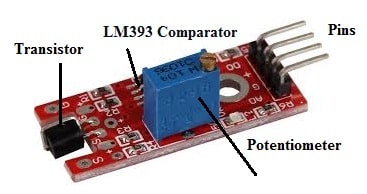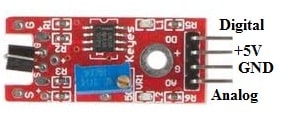The history of a metal touch sensor mostly matches the resistive touchscreen technology development by Dr. Samuel Hurst while researching at the University of Kentucky. So it was credited with discovering the primary touch sensor in 1971, which he named the “Elograph” which is a key component in the early resistive touch screen technology. After that, this invention led to the creation of the Eurographics Corporation, which established the expansion of transparent touch panels. Metal touch sensors are frequently based on capacitive principles and are used in different applications like smartphones, interactive displays, tablets, etc. Thus, this article elaborates on the KY-036 Sensor Module, pinout, features, specifications, and applications.
What is the KY-036 Sensor Module?
The KY-036 Metal Touch Sensor Module is an analog/digital sensor that uses a transistor to detect changes in electrical conductivity. So when the transistor is touched with a finger, the conductivity changes and the module emits a digital and analog signal. The digital output can be used as a switch that changes state when touched. The analog output can measure the intensity of the touch. The detection threshold can be regulated using the on-board potentiometer. Thus, this module is compatible with popular microcontroller boards like Arduino, ESP32, ESP8266, and Raspberry.
How KY-036 Sensor Module Work?
KY-036 metal touch sensor functions by detecting a change within electrical capacitance whenever a metal piece or a finger strokes its sensitive metal tip, basically working like a switch that activates a signal whenever touched. So this change is generally detected by a high-frequency transistor in the sensor. After that, it sends a signal to a microcontroller once a touch is registered by allowing for applications like interactive interfaces or touch-based buttons.
This sensor module functionality can be separated into three main components. First, the sensor unit is at the face of the module that measures the region physically and transmits an analog signal to the next unit like the amplifier. So this amplifies the signal and based on the potentiometer’s resistance value, it transmits the signal to the module’s analog o/p. This sensors sensitivity can be adjusted by adjusting the potentiometer’s knob.
If you turn it in a clockwise direction then you can enhance the sensitivity. Similarly, if you turn it in an anti-clockwise direction then you can decrease the sensitivity. Thus, the comparator switches the digital out and switches on the LED if the signal drops below a specific value.
KY-036 Sensor Module Components:
The KY-036 touch sensor module includes different components like the Darlington transistor, 3296W potentiometer, LM393 comparator & LEDs. So this module uses a floating lead on a Darlington transistor to sense a touch. So there are two LEDs on the sensor module board red and green LED. The red LED lights whenever power is provided thus the green LED lights whenever a touch is sensed.

Components
KY-036 is a simple module that can be integrated easily into any application circuit. So it can be connected easily to an MCU with three pins of module VCC, GND & Signal. The signal pin will go high whenever the sensor module is touched and this pin will go low whenever the touch is noticed. So this sensor module can be used in different applications wherever touch sensing is necessary like touch screens, buttons, human-machine interfaces, etc.
Pin Configuration:
The pin configuration of the KY-036 sensor module is shown below. So this module includes four pins which are explained below.

KY-036 Module Pin Configuration
- Pin-1 (Digital Signal): This pin outputs a digital signal whenever the metal tip is stroked
- Pin-2 (+V): It is a positive power supply or +VCC that supplies to the module.
- Pin-3 (GND): It is a negative power supply pin of the module.
- Pin-4 (Analog Signal): This pin outputs the sensor’s direct measured value.
Features & Specifications:
The features and specifications of the KY-036 sensor module include the following.
- KY-036 is a metal touch sensor module.
- This module includes four pins.
- The detection threshold of this module can be adjusted with a potentiometer.
- It is efficient for mainly battery-powered devices.
- It includes both analog & digital outputs.
- The module includes two indicator LEDs like; a red LED & a green LED.
- This module has an LM393 comparator chip.
- Its operating voltage is 5V.
- The output signal is Low-level or Digital.
- It operates powerfully with low-power requirements.
- It allows the users to put the touch detection threshold depending on their needs.
- This module has a compact design and easy to use.
- Its operating temperature ranges from -20°C and 85°C.
Equivalents & Alternatives
Equivalents to the KY-036 sensor module are; the Robodo TTP22301 module, TTP223B digital touch sensor, and capacitive touch switch module. So alternatives to KY-036 metal touch sensor module are; TTP223, TTP229, TTP226, TTP230, etc.
KY-036 Sensor Module Interfacing with Arduino Uno
The KY-036 sensor module interfacing with Arduino Uno is shown below. So the required components to make this interfacing include a KY-036 metal touch sensor, Arduino Uno, and connecting wires.
The connections of this interfacing follow as;
- Connect the GND pin of the KY-036 metal touch sensor with the GND pin of the Arduino Uno.
- Connect the VCC pin of the sensor module with the 5V pin of the Arduino board.
- The digital pin of the module is connected to the digital pin-8 of the Arduino board.
- The 5V LED is connected with pin-13 of the Arduino board.

KY-036 Metal Touch Sensor Interfacing with Arduino Uno
Code:
The required code for interfacing the KY-036 sensor module with Arduino Uno is shown below.
int led = 13;
int val, sensorpin = 9;
void setup() {
pinMode (led,OUTPUT);
pinMode (sensorpin,INPUT);
}
void loop() {
val= digitalRead(sensorpin);
if (val==HIGH)
{
digitalWrite (led, HIGH);
}
else
{
digitalWrite (led, LOW);
}
}
Once the above code is uploaded, supply this interfacing, If you touch the sensor module then you will be capable of controlling the LED.
Advantages & Disadvantages
The advantages of the KY-036 metal touch sensor include the following.
- This sensor module includes a potentiometer so it allows operators to set the sensitivity level of touch to suit their requirements.
- It operates with less power consumption.
- This module provides very-clear low or high signal output to interface with different microcontrollers.
- These are cost-effective
- It is particularly designed to notice touch on different metal surfaces.
- This module is simple to use.
- This is a versatile module.
- This sensor allows you to make interactive projects & touch-sensitive interfaces.
The disadvantages of the KY-036 metal touch sensor include the following.
- It is sensitive to different environmental factors.
- It is potential for false positives because of the electromagnetic interference.
- This module has limited sensitivity adjustment through the potentiometer.
- It is not suitable for applications that need exact touch detection (or) wherever non-metal things might be there.
KY-036 Sensor Module Applications
The applications of the KY-036 metal touch sensor include the following.
- The KY-036 metal touch sensor is used to control different loads in touch-activated switches.
- These are used in security systems to detect unauthorized access (or) tampering with metal objects.
- These are applicable in industrial automation to monitor metal tools’ position, machine parts, items counting on a conveyor belt/
- It is used in an interactive art installation for triggering sound, light, or different effects depending on touch interaction through the sensor.
- It is used in human-machine interfaces for creating touch-sensitive buttons or panels for user interaction.
- These are used in educational projects to design touch-based projects.
Please refer to this link for the KY-036 metal touch sensor datasheet.
Thus, this is an overview of the KY-036 metal touch sensor module, its working, and its applications. So it is a small electronic module that detects whenever a conductive material touches a metal touch switch. It provides a digital output signal once a touch is noticed and its sensitivity can be adjusted with a potentiometer. So it is applicable wherever a simple touch input is required like control systems, interactive projects, HMI, etc. Here is a question for you, what is the TTP22301 module?